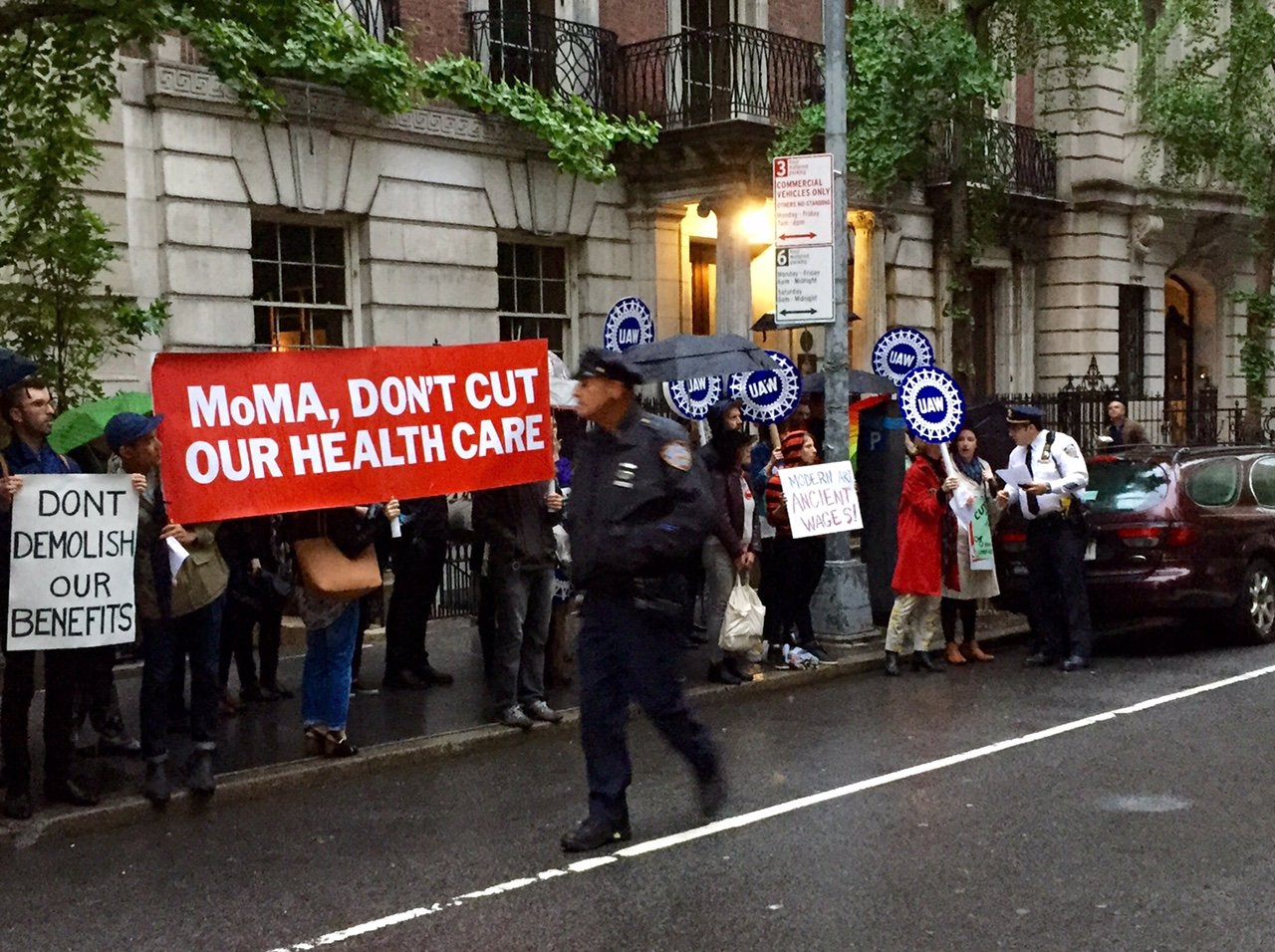
Workers at New York’s Museum of Modern Art are gearing up for a fight amid slow-going contract negotiations between their union, MoMA Local 2110, and the institution. At issue are staff concerns ranging from medical costs to wage increases and job security. And to make its case, the union is turning to a familiar—and decidedly public—tactic.
The current contract was last renewed in 2015 after several weeks of back and forth that saw staff confront director Glenn Lowry with an open letter and protest outside the Party in the Garden, the museum’s swanky annual fundraising event. The union is looking to repeat that action on Thursday, at what they’ve dubbed the Party on the Pavement. Before guests head inside—where St. Vincent will be performing in the sculpture garden—the union is inviting museum supporters to stand in solidarity with its workers.
“If you love MoMA and modern art, if you care about labor and social justice, or if you just want to spend an hour or two fighting for something good with an amazing bunch of people, please join us in getting the message to MoMA—it’s gonna be fabulous, feisty, family-friendly, and fun AF,” reads a post on MoMA Local 2110’s Instagram account, which encourages attendees to don cocktail attire. “Going to the Party in the Garden dinner or after-party? No problem! Hang out with us first, and then in you go.”
Among the union’s primary concerns are out-of-pocket healthcare costs to workers. The 2015 labor negotiation was resolved largely in the workers’ favor, with MoMA agreeing to preserve the existing healthcare plan offering free coverage for single payers. But in an email to artnet News, union president Maida Rosenstein said that the plan increased employee’s out-of-pocket medical costs. Now, she claims, “the museum is refusing to consider any relief on out of pocket health care costs.”
The union is also opposing the proposed elimination of scheduled “step increases” to wages, which give employees a roughly five percent raise after five years with the same job title. MoMA Local 2110 represents some 260 employees including museum retail and lobby staff, librarians, archivists, finance staff, curators, editors, graphic artists, development, conservationists, and administrative assistants. Rosenstein says that eliminating the step increases will hurt the majority of those staffers. “More than half of our unit has been classified by the museum as ineligible for overtime,” she said. “Without the seniority increases, rates will be devastated.”
The union also cited the institution’s desire to hire more temporary workers who do not receive benefits, and its refusal to provide more job security for curatorial assistants. “The assistants are the only union classification that does not include just cause protection for job loss. In the past, the museum regularly promoted a larger percentage of the curatorial assistants than they do now,” Rosenstein said. “Now, however, they must work as hard as possible and hope that they will be promoted to an assistant curator. Instead, most are let go. The museum wants to codify these terminations by referring to them as ‘graduation.'”
With negotiations now in their second month, MoMA Local 2110 has drawn a parallel between the current conditions and worker’s strike in 2000, which lasted 134 days. That strike took place “in the shadow of a large expansion project,” according to a union Instagram post. “Now, as we’re working overtime to get ready for the opening of new buildings, galleries, exhibitions, and entire programs in 2019, the museum is asking us to accept lower wages,” (In 2019, MoMA will open 50,000 square feet in new gallery space.)
The current negotiations, which began in April, have seen employees wear union shirts to a staff appreciation event held at the museum.
In an email to artnet News, a MoMA representative praised the staff and promised that the museum would work with the union to reach an agreement: “MoMA’s extraordinary staff are the best in the world. We are committed to working with the Local 2110 to reach an agreement that will keep our community of dedicated staff and the museum on a path of financial stability and future growth.”
The union’s social media campaign, however, offered a more pointed argument. In an Instagram post, it summed up its position this way:
The museum has long positioned itself as a place of progressive values, embracing the radicalism of the avant-garde and the art of feminists, AIDS activists, anti-capitalists, war protesters, and many others engaged in working toward a fairer and more equal society. Yet—MoMA is willing to exploit its staff, many of whom work hours and hours of unpaid overtime.